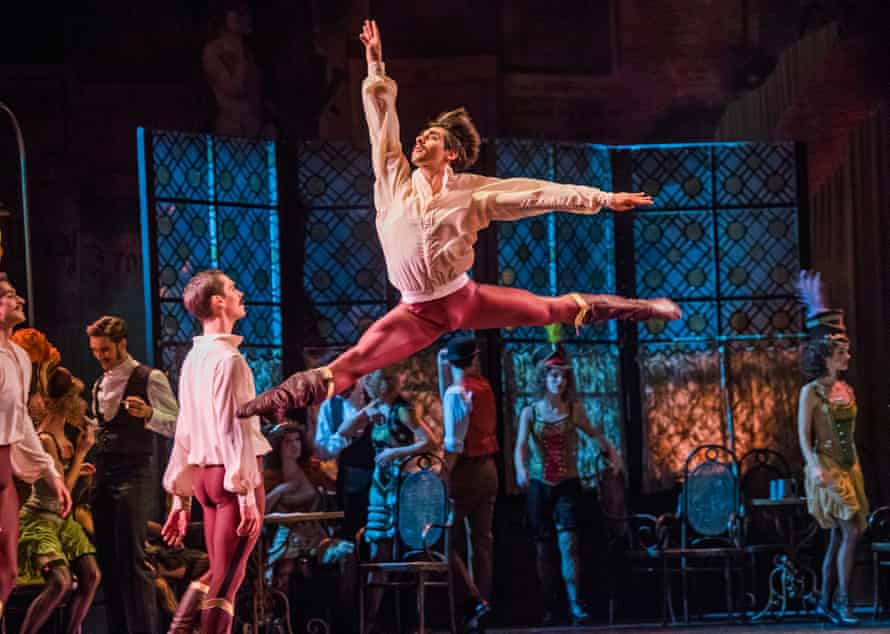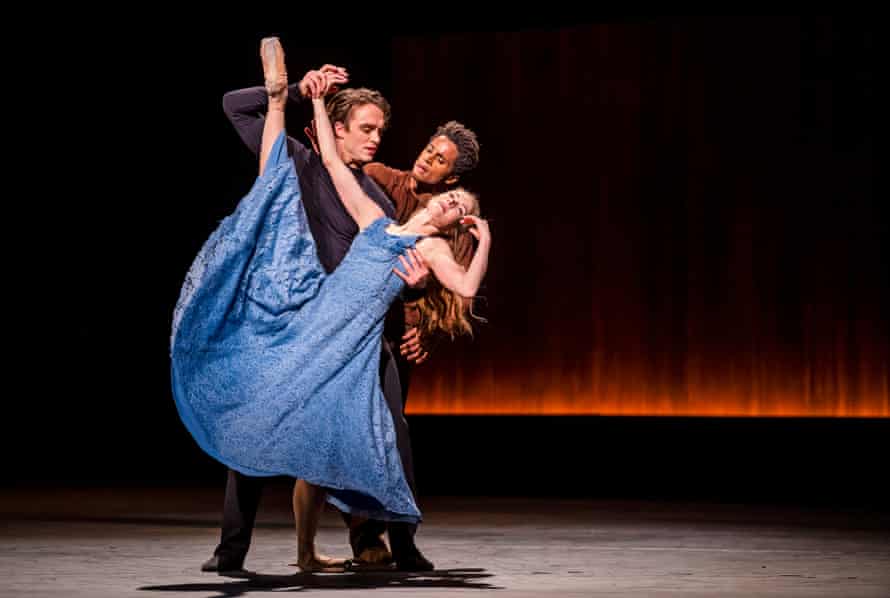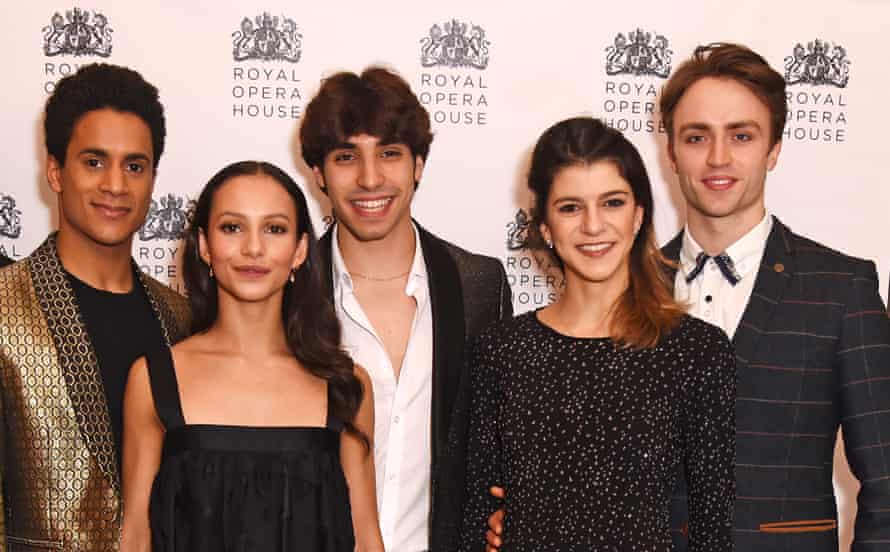Do Male Ballet Dancers Have a Family Life
'I t'south a golden era of male person ballet dancers." So says Emma Cahusac, the commissioning editor behind a new documentary, Men at the Barre, part of BBC 4's dance flavour. It's not just hyperbole. The immature men rise up at the Royal Ballet are some of the nearly heady in dance right now: principals Matthew Ball and Marcelino Sambé, first soloists Cesar Corrales and William Bracewell, and first artist Joseph Sissens all characteristic in Men at the Barre. With the majority of them British or United kingdom of great britain and northern ireland-trained, it's a giant bound from the grumblings of a decade ago about the lack of local dancers making it to the top.
I spoke to Ball, Corrales and Sambé by telephone, all staying resolutely positive during this enforced break from their intensive dancing lives, but all desperate to get dorsum to work with colleagues they're sure are something special. "I meet and so much beauty and and then much strength and power in that company," says Sambé. "There has been a surge in this younger generation," says Brawl.
Why this wealth of talent has arrived correct now isn't like shooting fish in a barrel to pinpoint, but they definitely spur each other on. There's healthy contest – ballet boys can't resist a pirouette-off; Corrales' record is "at to the lowest degree 15" – but they all talk about how secure they feel because each dancer is very different.

Liverpool-born Ball, 26, who trained at the Imperial Ballet School from the historic period of 11, is the tall athlete-poet with a flair for drama. He took leave from the Majestic Ballet to make a dazzlingly seductive turn in Matthew Bourne's Swan Lake and his interests lie in graphic symbol and storytelling. "He's well-nigh dancing with his brain," says Sambé. "There'southward always something so intense going on; he'southward bubbling, bubbles, bubbling."
Ball and Sambé have been friends since the latter joined the Royal Ballet Upper School at xvi. "Marcelino is then full of energy and vivacity and life," says Brawl. "That'south his personality and his dancing matches that. When you lot see him move information technology's similar a fish to h2o, it just makes sense." Sambé's joy as he springs and bounds has fabricated him an outright audience favourite, although he admits his beaming smiling was originally a mechanism for coping with nerves. "The ane thing that made me feel comfortable was a big smile, to connect with the audience," he says.
Corrales, at 23, is the virtuoso prodigy. The son of Cuban ballet dancers, raised in Canada, he joined English National Ballet aged 17, was a primary at 20 and moved to the Imperial two years ago. "He'due south a real firecracker," says Ball. "He certainly pushes us to accomplish i more centimetre higher or an extra turn. People often talk almost British dancers beingness controlled or mannered and that's something I personally don't want to buy into."
A notable line in Men at the Barre comes from ballet principal Christopher Carr, who was a dancer in the Regal Ballet in the era of Rudolf Nureyev. He says that if Nureyev was around now, he wouldn't exist such a big star: "In that location are now better dancers." Corrales takes issue with that. "Nureyev was on another planet!" he says. Just information technology's truthful that while Nureyev was ahead of his fourth dimension, and had blazing power and charisma, there are technically better dancers with every generation. The expectations on young dancers now are much greater than their predecessors. Everything is bigger, faster, college; training draws on hi-tech sports science, and they must master not only the exactitudes of classical technique, but be versatile enough to perform the virtually contortive gimmicky moves. They don't just follow directions, either, but help develop movement with choreographers. "It's very dissimilar to other generations," says Corrales. "You lot need to have that skill of contributing, bringing ideas to the table."

With two ballet dancers for parents, Corrales had the genes and the fix-upward for a smooth career path. In Cuba dancers are revered, with footballer-like status, merely growing up in Canada he experienced bullying, "especially since I was the smallest in the class," he says. He could express joy, because "they just had no clue" about dance, but at the aforementioned time he thinks that spurred him on to literally jump higher. "All those negative comments, the bullying in schoolhouse from a young age, gave me that ability and explosiveness to go who I am today."
The teasing Corrales experienced probably chimes with most people's expectations well-nigh the lingering stigma attached to boys who do ballet – mocking comments made by US television presenter Lara Spencer about Prince George doing ballet feature in Men at the Barre. Just it'southward not everyone'due south experience. Ball, whose mother is a trip the light fantastic teacher, remembers "leaving schoolhouse halfway through the solar day to get and audition in London and all the lads giving me loftier fives and wishing me good luck. I was actually quite supported, which some people might be surprised by, especially in Liverpool which is such a football city."
Different Ball and Corrales, Sambé doesn't come from a dancing background. From a poor family unit in Lisbon, his construction-worker male parent died when he was eight and he was fostered by another family with a daughter at the Lisbon Solarium, where Sambé studied. His primeval dance feel was in African trip the light fantastic toe and he first saw ballet on YouTube. He wouldn't have found his calling without information technology, he says, especially seeing black dancers such every bit Carlos Acosta. "An incredible moment, thinking, yeah, of course you can do this."

The internet has inevitably had a huge impact on this generation of dancers, and on the reach of an art form previously bars to the stage. Having a social media contour is function of the chore for dancers now, and the combination of gorgeous bodies and photogenic grit and strength has turned out to exist catnip for brands looking for ambassadors and influencers. The dancers' Instagram accounts reveal superhuman tricks and off-stage candour (Sambé has an account dedicated to his beautiful backstage shots of colleagues). Yous tin can cheque out how they've all been spending lockdown: Corrales and principal dancer girlfriend Francesca Hayward giddily laughing their way through multiple pirouettes; Ball and his partner, fellow dancer Mayara Magri, filming their plyometric fettle routine in the park. When we speak, Ball has just taken delivery of a shoulder rig for his camera, using the time off to explore his other creative interests – he thinks in that location'southward a lot of potential to better capture dance on moving picture.
Sambé has been painting and gardening, he tells me, and working on his ain choreography, some of which tin be seen in a film made (pre-lockdown) with Cloakroom mag, all undulating muscles and sharp turns. It's a hint of what'south to come, the choreography connecting to Sambé'southward first experience in African dance, a meshing of dance identities he wants to pursue. "To exist able to explore incredible ballet dancers' bodies doing this kind of movement I think will exist actually cool."
Ballet can be then much more than its traditional image, insists Sambé, just information technology means this generation breaking out of the ballet bubble. "I believe the art form is still in its infancy," he says, "and at that place'southward then much more to explore. We need to look out at what is happening in the globe, from politics to arts, and bring that into the ballet earth." More than always, immature dancers aren't just empty vessels, he says. "In that location are and so many layers to being an artist this way. The process is so rich and intense and visceral. The sacrifice brings such a specific grain and incredible force. I feel at that place's a misconception that we all just go on stage and look pretty, but no, at that place's so much more than."
-
Men at the Barre: Inside the Royal Ballet, is on BBC Four at 9pm on Midweek 27 May.
Source: https://www.theguardian.com/stage/2020/may/26/one-giant-leap-meet-the-new-generation-of-male-royal-ballet-stars
Postar um comentário for "Do Male Ballet Dancers Have a Family Life"